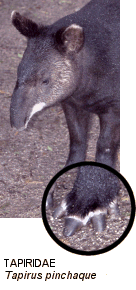 |
Tapirs possess several conservative physical features, resembling the earliest
perissodactyls in several ways, notably retaining the ancestral fourth digit
on the front feet. Tapirs are forest animals and feed on softer vegetation
- they have not developed the cursorial adaptations of the equids, nor the
high-crowned teeth for grazing on grass. Infant tapirs possess a striking
pattern of white stripes and spots over their bodies, providing camouflage
for their first 5-8 months.
Tapirs have an unusual disjunct distribution - they are the only New World perissodactyls (three species inhabit Central and South America), but one species is native to Asia. The fossil record indicates this group evolved in what is now North America, arising during the early Eocene and spreading to Asia during the Miocene and to South America during the Pleistocene. Subsequently, tapirs became extinct across most of North America, probably due to climate change - southern Mexico is currently the most northern extent of the range of Baird's tapir (Tapirus bairdii). The family tree (below) is not fully resolved; while the American tapirs would logically group together (as shown here), some genetic studies have clustered the Baird's tapir (Tapirus bairdii) next to the Asian tapir (Tapirus indicus), away from the other two American species. The upper lip and nose of tapirs are extended into a short prehensile trunk, which is one of the most recognizable features of this group. To accommodate this proboscis, the nasal bones of the skull are short and project forward. Tapirs retain the full eutherian complement of teeth: the dental formula is I 3/3, C 1/1, P 4/4, M 3/3 x 2 = 44. |
(From Norman and Ashley, 2000)
| Tapirus pinchaque
Tapirus terrestris |
or jump to the Tapiridae Species List